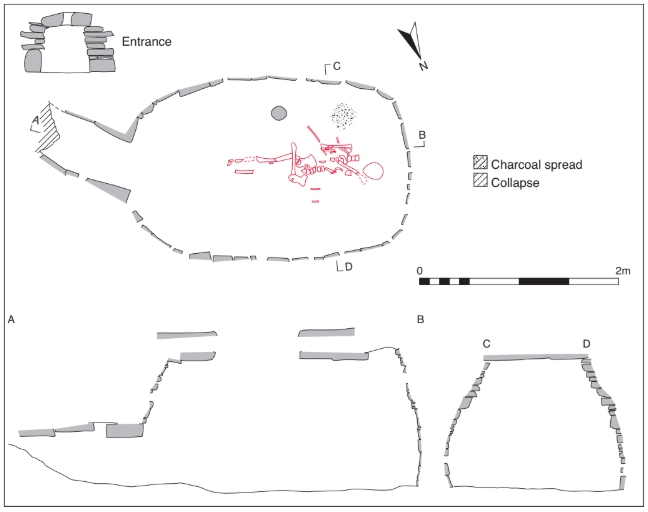County: Kerry Site name: KILL, CO. KERRY
Sites and Monuments Record No.: SMR KE020-001SMR KE021-00101 Licence number: E1078
Author: MARY CAHIL
Site type: Iron Age and early medieval graves, c. 300 BCc. AD 1200
Period/Dating: —
ITM: E 475848m, N 625786m
Latitude, Longitude (decimal degrees): 52.369566, -9.823190
Introduction
In March 1987 an inhumation burial was discovered in a souterrain near Ballyheige, Co. Kerry. The site was accidentally uncovered when part of the roof of the chamber collapsed. The landowner, Tom Collins, reported the find to the NMI. A four-day rescue excavation was undertaken by Mary Cahill, assisted by Conor Newman. The human remains were examined by Barra Ó Donnabháin.

Location (Fig. 4.16)
The site was in the townland of Kill, 1km west of the coast and 2km south of Ballyeheige, north Co. Kerry,36 at an altitude of 0–10m above sea level. It was located within a large, approximately circular enclosure of over 29 acres, which forms the townland of Kill. Local tradition refers to a church site within the enclosure, and the SMR lists a children’s burial ground37 at this location.
Description of site
The souterrain chamber was subrectangular in plan, measuring 2.75m by 1.75m by 1.32m (Fig. 4.17). The walls were built of small stones and roofed with large slabs. All of the stone appears to be local. The passage had collapsed in antiquity and only a small section, 0.7m long by 0.5m wide by 0.45m high, could be surveyed. No excavation of the chamber or passage took place, the purpose being to recover the skeleton. The floor of the chamber was compact and may have been lined with boulder clay.

The skeleton was placed on the floor of the souterrain without any covering of earth or slabs.
The burial consisted of an extended inhumation and the remains were those of a young adult female (1987:103). It was lying west/east with the head at the west. The bones were in very poor condition and had suffered some disturbance, probably owing to animal activity. The human remains were radiocarbon-dated and yielded a date of 1180±60 BP, which calibrates to 690–983.38
Comment
Burials within souterrains are not common but not entirely unknown in Ireland. Clinton (2001, 201) cites examples in Ballyarra, Co. Cork, where the remains of a child were recovered from a souterrain, and burials were also found in souterrains at Ballyboley, Co. Antrim, and Castle Balfour Demesne, Co. Fermanagh.
HUMAN REMAINS
BARRA Ó DONNABHÁIN
Introduction
One skeleton (1987:103) was submitted for analysis. The remains are badly preserved though the skeleton is mostly complete. The skull, most vertebrae and most of the long bones were recovered. The latter are in an extremely fragmentary state. Fragments of at least seven ribs and a few of the bones of the hands and feet are also present.
Age and sex
The secondary sexual characteristics of both the pelvis and skull indicate that this was a female. The state of fusion of the endocranial sutures of the skull and the pattern of dental attrition encountered suggest that this individual was a younger adult.
Stature
Using the regression equations of Trotter and Gleser (1952; 1958) it is possible to estimate that the maximum living stature of this individual was about 164cm. Long bone measurements are listed in Table 4.3.
Teeth
The following teeth were recovered:

The presence of unhealed tooth sockets indicates that the following teeth were also present at the time of death:

The portion of the left maxilla that contained the premolars and the first two molars was not recovered.
Dental attrition was mild, with the secondary dentine exposed only on the first molars. Wear on the other molars was confined to the enamel. Attrition is more marked on the anterior teeth than on the molars, caused by habitual clenching and grinding of the teeth. This condition—bruxism—is a common response to psychological stress and chronic pain. All of the teeth have a moderate amount of calculus formation.
Pathology and anomaly
A mild form of cribra orbitalia occurs in both orbits of this individual. This is a condition of unknown aetiology though it is commonly accepted as evidence of anaemia owing to an inadequate diet and/or chronic illness. This condition has been found in many early population groups. An Inca bone occurs at the junction of the parietals and occipital. This is a normal variation of skeletal form.
Table 4.3—Long bone measurements.

36. Parish of Ardfert, barony of Clanmaurice. SMR KE020-001——. IGR 075871 125736.
37. SMR KE021-00101——.
38. GrN-17625.